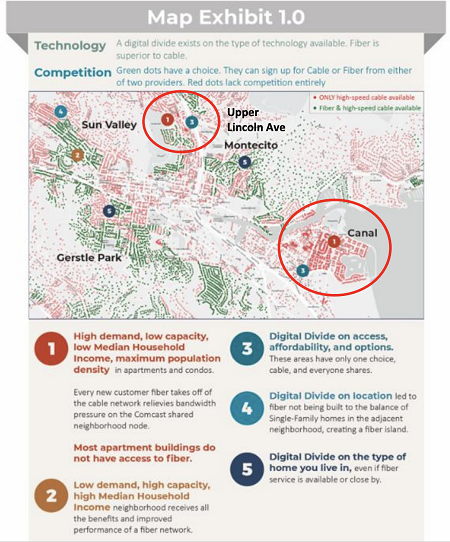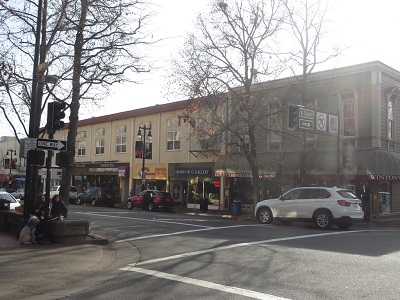
Fast, affordable Internet access for all.

Creative efforts are underway in Marin County, California to bring fiber connectivity to underserved pockets of the community and eventually the whole area. Digital Marin, currently housed within the county’s Information Services and Technology Department, is coordinating the project, and is leaning towards a municipally-owned, open-access solution modeled after Ammon’s standout network in Idaho.
Just across the Golden Gate Strait from San Francisco, Marin County is home to about 265,000 residents, as well as the Muir Woods National Monument, a County Civic Center designed by Frank Lloyd Wright, and nearly 73 miles of coastal trail. Despite largely being considered an urban county, Marin also includes suburban and rural areas with 40 percent of the county classified as protected park land.
When it comes to Internet connectivity, the area is peppered with what Marin County resident and Digital Marin Executive Steering Committee member, Bruce Vogen, calls “donut holes of high-quality Internet access.” An unknown provider built a DSL network in the region many years ago and then Comcast later bought and inherited the antiquated infrastructure. Soon after, AT&T entered the market but selected only the most profitable neighborhoods to serve. All 90,000 of the county’s urban households can access the Internet through Comcast, but just 20,000 of these homes have access to the archipelago of AT&T’s fiber network. In any case, Marin’s urban areas are either subject to monopoly or duopoly market control. It has long been apparent there is a digital divide in Marin County, but it wasn’t until the 2022 FCC maps were released that the contours of this divide came into focus.

The maps provided evidence for connectivity differences the county had already recognized, but they also revealed the extent to which incumbent providers had bypassed multiple dwelling units, or MDUs. In large part, areas with high concentrations of apartment buildings were left underserved. Beyond that, Digital Marin learned that areas left unserved or underserved were not only due to whether a family could afford home Internet service, but also about what community or neighborhood they lived in, what side of the street their house was on, and what type of housing they had.
Though the release of the FCC maps was a catalyst for Marin County’s broadband project, efforts had begun years prior. Before COVID, the county’s Chief Information Officer, Liza Massey, had initiated a project with the county board of supervisors to develop a broadband plan for Marin. These efforts, which included 47 focus groups and 12 surveys, were all-inclusive, drawing from the perspectives of cities within the county, educational institutions, businesses, and residents.
Under contract with EntryPoint Networks — the consulting firm responsible for spearheading Ammon’s exemplary automated open access network — Digital Marin has identified a number of issues with the way Internet service currently works in the area. A recent implementation report reads:
Today’s digital highways are susceptible to monopoly control, there is no local influence over pricing, governance, or quality of infrastructure, and the interests of incumbents are misaligned with the interests of subscribers.
Digital Marin aims to ensure that everyone within the county has access to a high-quality connection, and that efforts to connect residents are community-driven.
‘Defining the Problem’
Marin has been working with EntryPoint to develop a plan for this community-driven approach, and though the county was not set on public ownership from the beginning, Marin is now leaning towards an automated, municipally-owned, open-access network where network construction, network provision, and end-user service are all separate. The network will invite a variety of different providers to offer retail Internet service, but will also have specialized uses related to education, telehealth, and security. All last-mile connections will be fiber, with the exception of some difficult-to-reach locations across the county. EntryPoint will determine an estimate for the total cost of building a county-wide open-access network and present this to Marin’s board of supervisors soon.

As Bruce Vogen told ILSR, Digital Marin is currently in the process of “better defining the [connectivity] problems” of the area, as well as identifying the appropriate broadband solutions. The county and the cities it serves have so far received nearly $1 million in funding from the California Public Utilities Commission’s (CPUC) Local Agency Technical Assistance (LATA) grant program, and hope to see another significant amount come through soon. The funding will cover EntryPoint’s cost assessment and construction design work in five areas where a digital divide has been identified, including along the coast — a rural area dotted with small communities either unserved or underserved by FCC standards.
EntryPoint’s planning work will prepare the county and its communities for state and federal funding opportunities, including money from the California Advanced Services Fund (CASF), California’s Last Mile Federal Funding Account, and Broadband Equity, Access, and Deployment (BEAD) grants.
Digital Marin is confident several communities within the county will qualify for federal funding, but those that do not will need to make decisions about whether to build their own publicly-owned networks using other funding sources such as municipal bonds. Still, Marin County’s work with EntryPoint means that these communities that do not qualify for federal funding will have up-to-date feasibility studies to help them make decisions about how to move forward. EntryPoint’s planning report is about 95 percent complete.
The county plans to leverage the areas that are eligible for federal funding as pilots for the open access model it hopes to scale. While Digital Marin’s short-term plans (over the next two to three years) include multiple targeted builds, there are long term visions of county-wide open access, which speaks to the ambitions captured in the name “Digital Marin” and an end-goal to create a technologically ‘smart’ region.
Digital Marin is also working with the county’s cities to discourage them from seeking out single providers that lock residents into service without a choice of options. Having a single private provider dominate the market would disrupt what Liza Massey recognizes as “an opportunity [Marin] may not have again to get true open access and be able to have an impact of affordability, quality and choice for [its] residents.”
County Officials Eye Multi-Dwelling Units
One of the communities that may be eligible for federal grant money is the Canal neighborhood within the city of San Rafael. However, the path to getting the necessary funding is an interesting one. San Rafael is an urban area that is considered technically served by the FCC, meaning the FCC considers the entire city to have access to broadband that offers a minimum of 25/3 Megabits per second (Mbps) connectivity. But, the Canal neighborhood – a low-income, largely Latinx neighborhood with a high concentration of apartment buildings – struggles with poor connectivity in many of its individual apartment units.
EntryPoint and Digital Marin hope to capitalize on a clause in the BEAD legislation that leaves room for grant funds to be used for connecting MDUs where any number of individual units in the building do not have access to broadband of at least 25/3 Mbps. The City of San Rafael itself received just under $260,000 in LATA funding to study this problem. Though it is an experimental case, Digital Marin hopes to use the Canal neighborhood as an example of how federal funding can be used to expand connectivity in a ‘served’ area.

At the beginning of the pandemic in 2020, the Canal neighborhood built a mesh network to connect students. The project delivered wireless broadband to more than just school-age children; the network also expanded connectivity across the neighborhood. However, it did not provide ubiquitous access. Digital Marin plans to eventually replace the network with fiber, but leave free Wi-Fi in public spaces like the library and community center.
Marin County Planning for Next 30 to 50 years
Marin is particularly well situated to move forward with building a fiber network. Thanks to the State of California Middle-Mile Broadband Initiative, which will deploy 10,000 miles of fiber infrastructure before the end of 2026, the county will have its own middle-mile fiber loop, bringing reliable connectivity to the area at state-regulated rates. The state’s investment removes some of the risk from Marin’s planned last-mile, as it provides redundancy. The loop will actually run right through three unserved or underserved communities on the coast, locking in Digital Marin’s projected work in the area. These last-mile projects will happen in parallel to the state buildout.
Marin’s own fiber ring, however, was not part of the initial statewide middle-mile proposal. The county is part of a broadband consortium of four counties, and alongside Sonoma, Napa, Mendocino, worked closely with the state to get additional fiber infrastructure written into the proposal.
As the county moves forward, Liza Massey noted how helpful it was to collaborate directly with the California Department of Technology, the California Public Utilities Commission, and the Middle Mile Advisory Committee.
We’re taking advantage of this [opportunity] to go out there and build what is a once-in-a-lifetime opportunity that will impact Marin County for the next 30 to 50 years. Finally, local government is getting recognition that we can be part of the solution.
Header image of Marin County mountains courtesy of Philippe Gauthier on Unsplash
Inline image of San Rafael courtesy of Flickr user X, Attribution-ShareAlike 2.0 Generic (CC BY-SA 2.0)
